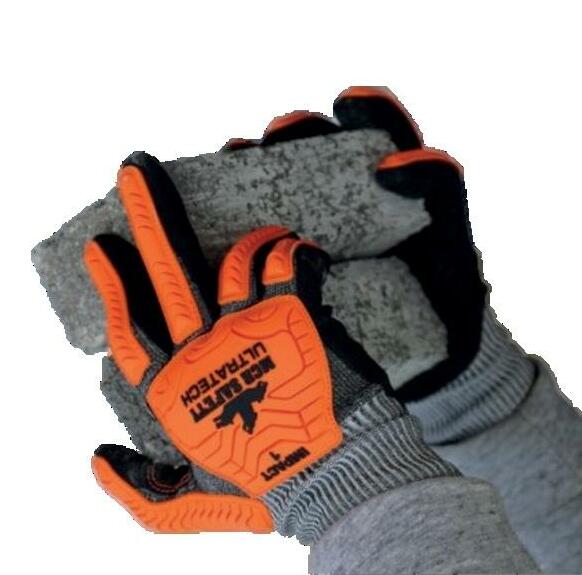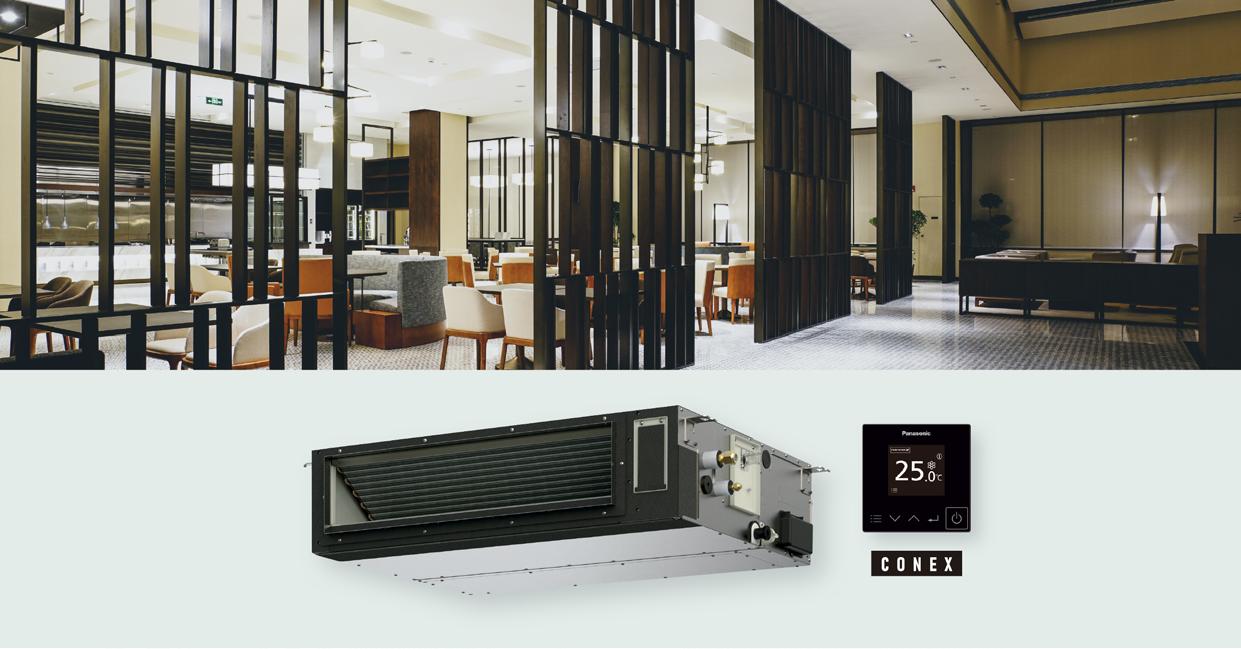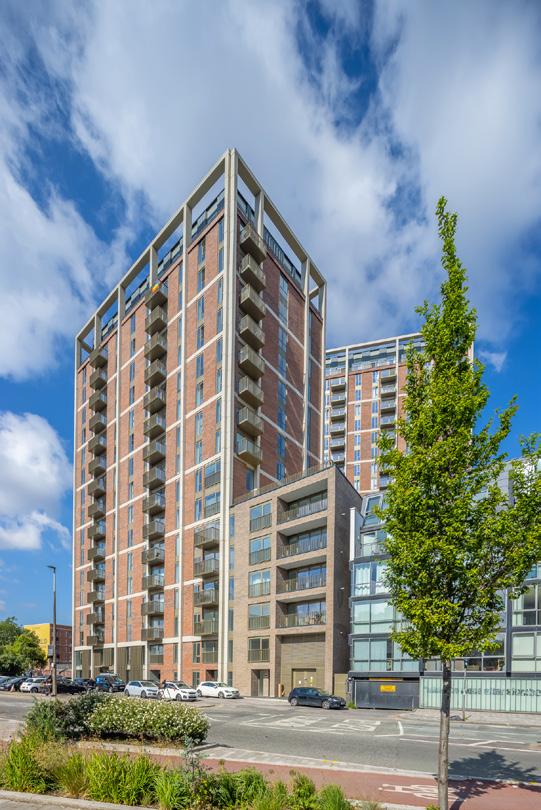
15 minute read
Safety Workwear
Specialist Hand Protection for Construction Workers
Your hands - the most valuable tool you have
Advertisement
Your hands are without doubt your most valuable tool; they’re versatile, strong, always by your side and like your best friend, they’ll never let you down.
However, they’re also precious, sensitive and you only get one pair to last your entire life. That’s why getting the correct hand protection is a serious matter and one that should be considered very carefully.
There are hundreds, possibly even thousands of different gloves available in today’s market. It’s great to have choice but sometimes it leads to confusion and a lack of clarity. That’s why MCR Safety have categorised the options to help you make the right choice for you.
General Handling Heroes

MCR Safety offer an extensive range of General Handling work gloves; they come with a variety of different protective properties to suit different tasks and operations throughout the Construction Industry.
They’re especially suitable for use in Construction, Building and Trades because they’ll protect your hands from the scrapes and grazes you encounter on a daily basis.
They’re great for handling rough objects like bricks and breeze blocks, protecting your hand and improving your natural grip.
They’ll also protect your skin when in contact with abrasive surfaces like concrete, masonry and timber.
You can select from a range of coatings designed to improve, dexterity, breathability, grip and comfort. The range also includes options with touch-screen fingertips so you can operate tech without removing your gloves.
Lean more about General Handling Gloves
Cut Protection
Medium to Extreme Risk
Work gloves designed to offer any level of protection, by law, must be tested to EN388 which is a globally recognised standard. Gloves are tested for their resistance to abrasion, cut, tear and puncture and the combined score represents the overall protective value of the glove.
The score given for cut is the most relevant in high-risk environments; the highest rating is ‘F’.
When it comes to cut protection, MCR’s range starts at level ‘B’ and goes right through to ‘F’ . They represent this with a simple scale measuring from Medium through to Extreme protection. This is a quick and easy reference to help you navigate the range.
Levels of protection are determined by components and glove construction. Cut fibre yarns are used in conjunction with coatings and for some gloves at the extreme end of the scale, leather reinforcements are used.
The Construction Industry is one of the biggest users of impact protection gloves. Heavy objects are an obvious hazard and although safety regulations are stringent and personnel are properly trained; there is always risk of hand injury. Learn more about Cut-Protection Gloves


Armoury for Hands
MCR Safety’s impact protection gloves have robust armour to shield the back of your hand. It’s made from TPR (Thermo Plastic Rubber), an ideal material for impact protection because it’s incredibly tough but also surprisingly supple.

It’s applied in panels like the scales of a crocodile so it can flex with the hand through your full range of motion.
Learn more about Impact-Protection Gloves
Protective Eyewear.
MCR Safety also have a full range of protective eyewear and prescription safety eyewear.
Snickers Workwear = Comfort = Wellbeing and Improved Performance.
STRIDE OUT IN THE ALL-NEW WORK TROUSERS FROM SNICKERS WORKWEAR.

Snickers Workwear is continuing to make great strides in Work Trousers design and functionality while still increasing its commitment to environmental responsibility.
Sustainable fabrics, body-mapping designs and improved performance are key features in the all-New Work trousers for men and women. Wherever they’re working, whenever they’re on task and whatever the weather, there’s a pair of trousers to suit.
There’s new designs for both men and women with unrivalled functionality in the AllroundWork and FlexiWork ranges. The 4-Way Stretch features ensure maximum working mobility while the loose or slim fit designs deliver maximum working comfort all day, every day. With great ergonomic fit and superb value for money there’s optional features such as detachable holsters, Canvas+ fabrics for durablility and Cordura reinforcements for extra durability. You can also choose trousers with or without the KneeGuard® Pro System which will deliver certified knee protection if you need it.
Check out all the Work Trousers at snickersworkwear.co.uk – for the optimal choice for craftsmen and women who need to get every job done comfortably and efficiently on site.
Getting information on the Snickers’ new Stretch Trousers is easy. You can call the Snickers Helpline on 01484 854788, checkout the website and download a digital catalogue at www.snickersworkwear.co.uk or email sales@hultaforsgroup.co.uk

A
GROUNDBREAKING
new sports facility has opened in Colchester, designed by sports and leisure specialists GT3 Architects to combine the needs of both elite sports teams and local community groups.
Completed for Colchester Borough Council under the Scape Perfect Circle framework with Gleeds, RG Carter, AECOM and Pick Everard, the £29 million project delivers facilities that cater for the centre’s diverse range of stakeholders and creates a unique sports hub setting in the Northern Gateway area of the town.
The facilities include a new state of the art rugby pavilion with flexible function space, educational space, changing rooms and viewing gallery, across an array of new grass and 3G pitches for different sports and age groups. The site also contains a 1.5km closed circuit cycle racetrack, partly funded by British Cycling. The track caters for national competitions as well as local grass roots cycle clubs and community use, and includes a ‘learn to ride’ facility and pump track.
DESIGNING FOR PERFORMANCE ATHLETES

Central to the site and connecting to the pitches and racetrack is the council’s new dry sports centre. This houses a large flexible sports hall space including indoor cricket, gym space with dedicated equipment for cyclists, studios, velo studio, cycle hub, retail units, classroom space and a large café with views onto the 3G pitches and cycle track. Externally, the site is supported by a full-size archery range and equestrian trails.
Mark Gowdridge, director at GT3 Architects, said: “The opening of this exciting sports hub marks the result of a successful collaboration between all parties. With so many stakeholders involved – Colchester Borough Council, local residents and junior sports groups, Rugby Union and League, local College and schools, British Archery, English Cricket Board, Badminton England, Equestrian groups, local cycle clubs, Sport England and British Cycling – we needed to deliver a scheme that would suit everyone’s needs.
“Engaging with all parties via our Performance + engagement tool was crucial – understanding each user-group’s different goals, outcomes and concerns allowed us to design a facility mix which capitalises on the
PERFORMANCE ATHLETES

dynamics of space and maximises performance, ultimately delivering the best results for the people and organisations that will use it.
“It also allowed us to meet the leisure and fitness requirements for the wider local community, whilst delivering high-quality facilities needed for elite sport.”
The centre will address key health needs in the local area and provide a diverse range of facilities for the local community. Residents will benefit from facilities designed to an elite sport level and exercise alongside national athletes in the new cycle track and rugby training centre.
Mark added: “In addition to meeting the site’s diverse user needs, we needed to ensure the design was ecologically sound. We undertook extensive research to deliver a high performing design, sensitive to the local surroundings and which blurs the lines between inside and out.

“The scheme blends into its environment, with a strong use of timber in the main sports centre. The choice of materials is not only sensitive to the landscape but also ensures durability. We want the scheme to act as a high performing, welcoming fitness hub for both community wellbeing and elite sport for years to come.”
The leisure centre is now open and is already being used by the 900 junior members of the Colchester Rugby Club.
For further information visit www.gt3architects.com or join the conversation over on Twitter @_GT3Architects.

PANASONIC INTRODUCES REVOLUTIONARY ADAPTIVE DUCTED UNITS TO VRF RANGE

Panasonic Heating & Cooling Solutions introduces the Adaptive Ducted F3 range for its VRF systems, designed for retail, hotel and office applications.
The range features a new vertical mounting option and a choice of rear or bottom air inlet, increasing fitting possibilities. This, and a choice of 12 capacities, from 1.5 kW – 16 kW, provides very flexible options for installers.
Outstanding design and flexible installation
The Adaptive Ducted Units come in a compact design for the ultimate space-saving solution, with a height of just 250mm and ranges in weight from 26kg to 42kg, making it well adapted for projects requiring a more discreet fit. Although small, the design still allows for a powerful 150 Pa External Static Pressure, and optimal airflow set-up is possible depending on ducting design and conditions. It also features two integrated R32 refrigerant leak detectors for security. In addition, the unit’s design permits a smooth airflow, which helps to achieve an incredibly low noise operation down to a market-leading 20dBA, whilst still maintaining powerful pressure and therefore resulting
developer-update.co.uk
in quiet comfort for users. Smart sensors control Discharge Air Temperature for precise room temperature control and provide the possibility to reduce cold draughts during heating operation. A series highlight is the industryleading introduction of both horizontal and vertical installation options, which enables discrete placement outside the room even if a small ceiling limits space for ductwork – the unit’s drain pan is conveniently suitable for both horizontal and vertical installations. The range also allows for selectable rear or bottom air inlet thanks to its adjustable panels. The series includes a more powerful highlift, built-in drain pump that allows drain piping to be elevated up to 701mm from the base of the unit.
Superior air quality: 24/7 protection with nanoe™ X
The entire series has Panasonic’s maintenance-free nanoe™ X technology (Generator Mark 2 = 9,6 trillion Hydroxyl Radicals/ sec) built-in as standard. This innovative technology produces hydroxyl radicals (also known as OH radicals), which are abundant in nature and have the capacity to inhibit certain pollutants, viruses, and bacteria to clean and deodorise hard surfaces and soft furnishings, improving protection 24 hours a day, 7 days a week to ensure a pleasant environment for all. The technology is ideal for a wide range of applications, with nanoe™ X having a proven effect against odours in large spaces[1] .
Smart connectivity
Additionally, the Adaptive Ducted Units are compatible with all VRF controls including the new CONEX Controller with Bluetooth built-in and Apps for quick, convenient set-up. The innovative controller can be used through a smartphone or tablet with flexible, daily remotecontrol operation thanks to the Panasonic H&C Control App. The controller is also compatible with the Panasonic H&C Diagnosis App for analysis and troubleshooting.
For more information, please visit www.aircon.panasonic.eu

FUTURE HOMES SUSTAINABLE
CITIES by Wojciech Brozyna - MD of Aluprof UK
Around a third of all our energy use in the UK is used in our homes. With the majority of this energy used in heating, this equates to about forty MTOE (million tonnes of oil equivalent) used every year. The UK Government have some ambitious plans to cut energy usage by 2050 in many sectors. Glasgow will be hosting the 26th UN Climate Change Conference of the Parties (COP26), from 31 October to 12 November 2021 and the UK is striving to take a global lead to drastically cut carbon emissions.
The last change to our legislative window U-values for new homes was implemented in Approved Document, Part L in 2013. Little has changed since then, but, that is all set to change following the Government’s recent Future Homes Standard Consultation. The updated Part L will likely be finalised and released at the end of 2021 to be introduced into legislation early in 2022. This will likely mean the introduction of window systems having to meet a lower U-value of 1.2 W/m2K (in England) for the ‘notional’ building and the possible introduction of triple glazing. Following this change, it is likely that Part L will be further revised in 2025, possibly taking window U-values down to 0.8 W/m2K. The changes are the result of the Government mission to achieving net-zero carbon by 2050 and ensuring that new homes are built to be “zero-carbon ready” as the National Electricity Grid decarbonises.
With the introduction of revised air tightness requirement, down from the limiting value
developer-update.co.uk
of 10 m³/h.m² at 50Pa to 8 m³/h. m² at 50Pa (with 5.0 m3/h.m2 at 50Pa for the notional building) using the ‘blower door’ test method or a new ‘Pulse’ test method, our building structures are likely to become even more airtight. It is suggested that a house achieving an airtightness of 5 m³/h.m² will use 40% less energy on space heating than a house built to 2013 standards of 10 m³/h.m². With stricter airtightness, this calls into question how we can retain heat in our buildings in winter whilst maintaining healthy indoor air quality for wellbeing with controllable natural ventilation.
Will the change in thermal requirements in Part L and the revised guidance in Approved Document L Volume 1 change the material of choice for specifiers? Probably not, as both of the predominant materials chosen for new construction, aluminium and PVC, can achieve the U-values required, albeit they will be thicker, more thermally efficient and may carry triple or quadruple glazing, consequently products will become more expensive. Balancing this increased cost will be increased product quality which is likely to offer products an increased in-use life, possibly up to twice the current life expectancy.

There are three areas of carbon emissions we have to remember; the production and installation of a product, what the product can save (or use) during its useful life and what value it has at its end of life, or how it can be reused or recycled. Reducing the rate of replacement will significantly reduce carbon. In the future, we may be required to prove a carbon payback if a lesser performing product is to be replaced with a newer carbon saving product. Aluminium has proven its almost 100% recycling ability with no loss of structural strength, however, with long life comes the shortage of end of life recycling and currently, we can only supply up to 50% of the global demand for the material. Product recycling and sustainability are crucial if we are to ensure cyclical ‘cradle to cradle’ material resources in the future. Specifying aluminium will ensure its continued use for generations to come. 75% of all aluminium ever produced since 1880, when it became commercially viable, is still in use today. There will likely be a move to adopting differing designs of windows and doors in the future to make the most of high insulation glazing, such as reducing sightlines to a minimum. This may mean a move to sliding systems for large glazed opening doors and the adoption of tilt turn window systems. Will this herald a move away from the UK’s love of the outward opening ‘casement’ window?
What does seem to be missing in this rapid move towards increasing thermal efficiency and airtightness in our future builds is the need for air ventilation, particularly in our homes. This is crucial for our well-being and continued health. We know that sealing up a small dwelling will eventually lead to condensation appearing on the coolest elements in the room, sometimes a wall or an abutment with a ceiling, where dampness can turn quickly into unhealthy mould growth. This is particularly relevant in social housing where occupants may be reluctant to ventilate due to the cost incurred in reheating. It, therefore, seems logical for future legislation to include mechanical ventilation with efficient heat recovery, or indeed cooling of incoming fresh air depending on the time of year.
Another issue that we do need to attend to as an industry is the robust detailing of interfaces between windows and doors and the building structure. Cold bridges often decrease the claimed efficiencies within a building construction that can reduce the effectiveness in use of a designed build by up to 50% of its claimed thermal efficiency. As an industry, should we be doing more to incorporate or encourage the specification of interface designs that reduce cold bridging to an absolute minimum?
Here at Aluprof we already have an approved range of highefficiency windows, doors and curtain walls which all meet Passivhaus accreditation. As a member of the Passivhaus Trust in the UK we are supplying systems for new and refurbishment properties whilst working closely with the trust regarding installation. In each of our technical manuals, we show how our products can be installed to ensure the minimum of cold bridging. Our team of engineers are also on hand to work with architects and designers to help detail thermally efficient interfaces for Aluprof windows and doors into any structure.
Since setting up the Aluprof Office at the Business Design Centre in London, the company has rapidly grown their specification influence in the UK with their high-performance architectural aluminium systems. Further expansion of the company’s headquarters in Altrincham now provides specifiers with meeting facilities and an extensive showroom of commercial systems to view. With overseas growth across Europe spreading into the Middle East and firm roots already in the East of the USA, the company is becoming a global player in facade supply.
Further information is available on the company’s website at aluprof.co.uk or direct from their UK head office in Altrincham on 0161 941 4005.




